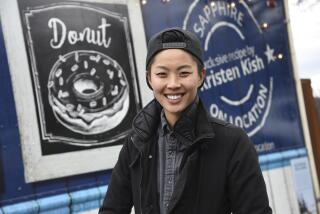Reading Nook: Nourishing both the mind and the stomach
- Share via
There is a space in our kitchen where I read. It’s a window bench made for one, possibly two if you are feeling intimate or are a teenager. Teenagers have a knack for wedging themselves into small spaces and braiding legs.
The window is big, like you could fit a piano through it if you had to. It’s paned glass — eight squares on the bottom, eight on the top. If I’m sitting on the side looking north, I can see the Hudson River over the rooftops of the Upper West Side in New York City. This isn’t a panoramic, sweeping view of the Mighty Hudson; it’s a lean-your-head-the-right-way-and-you-can-see-the-river-through-two-buildings view. A slice of the river. But the river it is. I’m not lying when I say I just saw a jolly cherry red-and-white tugboat chugging south. On the other edge of the river is New Jersey. As a born-and-raised Upper West Side girl, the Hudson River is my North Star.
I read (and work; I write on this window seat too) in the central nervous system of our apartment. I naturally want to be where the most people are, and even if everyone else who lives here is at school or work, I can feel their mojos. If I listen hard enough, I can still hear my husband grinding his coffee or the bing of the refrigerator when one of the kids has been standing in front of it too long with the door open. It feels friendly in here. I don’t mind if I’m interrupted by the sound of someone in the hall waiting for the elevator. At 8 a.m., our two clearly exhausted dogs, Maude and Duke, are asleep in their bed 4 feet away.
I would love to say that on most days I’m here in the corner reading deep and difficult fiction, or letters from poets to their lovers, but mainly I read cookbooks. Today, and for the past couple of months, I’ve been reading a collection of recipes edited by Leyla Moushabeck called “The Immigrant Cookbook.” The contributors are American chefs who immigrated here from all over the world.
At the top of each page is the chef’s name and country of origin. What follows is the story of the recipe and its cultural, familial and sometimes spiritual meaning to its author. Each curry, aguachile or noodle dish serves as a bridge from where it originated to how it lives on American shores. I want to cook all the recipes. Usually though, I read the cookbooks through before I buy the produce and fire up the stove.
I sold myself short earlier saying I feel guilty about not reading big-time novels, but the truth is, the stories in the pages of many cookbooks, especially in this one, are as profound and impactful as any novel. In “The Immigrant Cookbook,” I am reminded, as I sit in my nook in one of the most diverse cities in the world, that variety and the truth of who people are and where they came from is what I love.
Isabel Gillies is the author of the memoir “Happens Every Day,” the novel “Starry Night” and, most recently, “Cozy: The Art of Arranging Yourself in the World.”
More to Read
Eat your way across L.A.
Get our weekly Tasting Notes newsletter for reviews, news and more.
You may occasionally receive promotional content from the Los Angeles Times.









